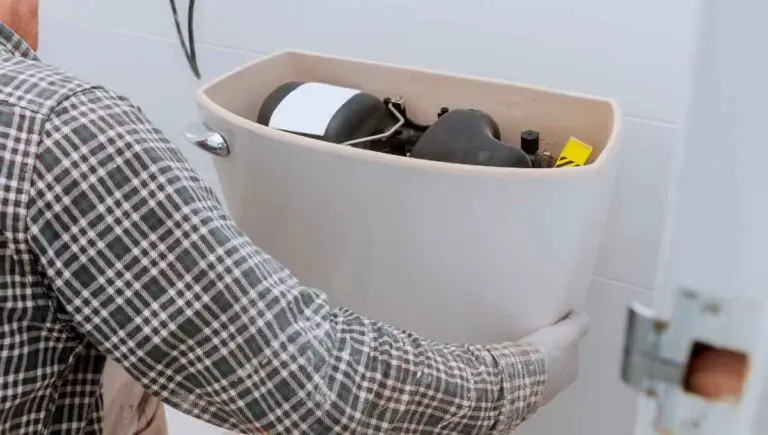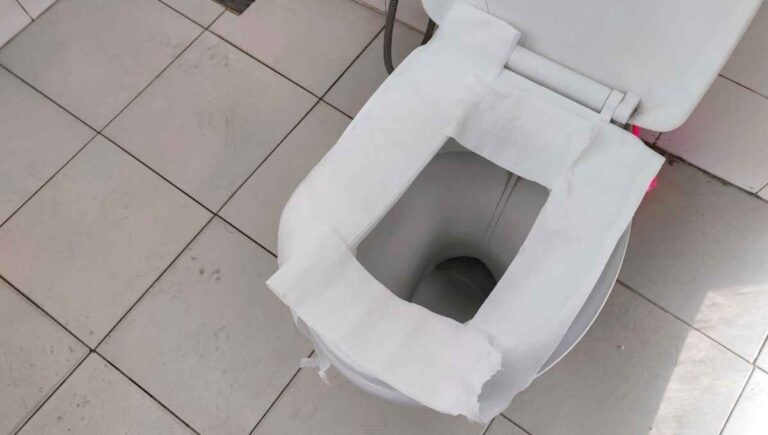How to Keep Tension Rods From Falling Down (Use This Trick)

Have you ever installed tension rods in your home and then watched them slowly fall down, time and time again? If so, you’re not alone. How do you keep your tension rods from falling down all the time?
You can prevent tension rods from falling down by tightening the rod in order to create more friction and pressure between the rod and your walls. Your curtains may also just be too heavy for your tension rod. In this case, you can try using a drill to secure the rod and make it more stable.
Hopefully, this article will help ease your tension about your constantly falling tension rod. Want more details? Wondering how you can put these strategies into practice? We can help! Just keep reading.
This post contains affiliate links. This means Household Blogger may earn a commission should you make a purchase using any of our links. Please refer to our full affiliate disclosure policy for full details.
Here’s a Quick Pro Tip!
If you’re stressing out that your tension rod is slacking off, try one of these great supports!
Here are some of our favorites from Amazon:
1. Ceiling Mounts – Use your ceiling to provide extra support for a sagging tension rod!
2. Mounted Brackets – A great way to give extra support to your tension rod, as long as you don’t mind drilling holes in your wall.
3. No-Drill Brackets -If drilling is a no-go, try these great stick-on brackets instead!
Why Is This Happening?
Usually, the first thing you’ll ask yourself about a problem is ‘why?’ Why is this happening to you and how are you going to fix it? We’ve got your answers.
Why Does My Tension Rod Keep Falling?
There are multiple reasons why your tension rod may keep falling down. For example, it may be because your walls are too smooth to hold them, your wall might not be able to withstand the tension needed, or your rod might be pushing in on itself.
Luckily, these issues can be easily fixed. If your wall is too smooth, you can buy glue and rubber shelf mats to create the texture the rods need to stay up.
You can also buy tension rod holders to keep your wall safe. This is useful if you have drywall and you’re concerned the wall will break if you tighten the rod too much.
Do Tension Shower Rods Work On Tile?
Tension rods work especially well on tile and fiberglass walls. They don’t require any drilling or mounting, so they will not leave lasting damage on your bathroom walls. They have an adjustable length and stay up when placed properly.
Choosing the right tension rod for your shower can be crucial to your comfort in your own bathroom.
Here are some tension rods to consider:
- BRIOFIX Tension Rod – Easy to install and attractive!
- No Rust Tension Rod – Specially designed to never rust!
How Much Weight Can A Tension Rod Support?
Tension rods can support up to 20 pounds of weight on them. Tension rods stay on walls through pressure created by pressing against two opposing walls. Because of this, they can’t hold as much as regular shower curtain rods.
However, the weight they do hold is more than enough for a regular shower curtain.
They are also more convenient because they don’t require any permanent mounting systems, which is perfect for those who are renting and don’t want to damage the walls.
Will Tension Rods Damage My Walls?
Tension rods do not damage walls if used correctly. They do not require any drilling or mounting to be used. Tension rods are able to stand on their own by the pressure between them and the two walls.
Tension rods may be less stable than others, but it is an excellent option under the right conditions.
This is especially true if you want an easy setup or if you want something that will leave your walls in the same condition as before. Just be cautious if you are trying to mount your tension rod on drywall.
Are Tension Rods Any Good?
Tension rods are a good option for all your hanging needs, especially if you are renting a place. Tension rods have no damage when set up or removed because they are only held up by the tension between them and the opposing walls.
However, they can’t hold as much weight as other rods because of this. If you have a heavy shower curtain, you’ll find that the rod will collapse often.
The two walls the rod is in between must be small enough for the rod to fit snuggly, so make sure you have the correct size before purchasing.
Can You Connect Tension Rods?
Tension rods can be connected, but you will need a special device to do so. This device screws into either end of both tension rods to increase their overall distance. You can grab one of these devices from Amazon.
These special devices help you to be able to use your tension rods for a variety of purposes. This is great because they are so easy to install.
They leave no marks on the walls because they use the pressure between them and the other walls to keep themselves aloft.
Can You Use A Tension Rod For A Shower?
A tension rod can be used for a shower. However, it is not the most stable solution. Because a tension rod only relies on pressure between itself and opposing walls, it can fall if enough weight is put on it.
A tension rod can be a great solution for those looking for something temporary, but in the long term, it can cause inconvenience if a lot of weight is put on it often.
If you want to make a tension rod more stable, you can always add adhesive or texture, depending on what kind of wall you have.
Is A Tension Rod The Same As A Shower Rod?
A tension rod can be used for the same purpose as a shower rod, but it is not the exact same thing. Tension rods use pressure between them and opposite walls to stay up. If too much weight is placed on them, they will fall down.
They can be a good temporary solution, but they may not be great if you are looking for something permanent, especially if you have heavy shower curtains.
You are able to reinforce tension rods with adhesive, but you might as well invest in a mounted shower rod if you’re willing to put in that work.
How To Fix an Unstable Tension Rod
If your tension rid is causing you stress, we get it. Having a tension rod fall down all the time is stressful. We’ve got some great ways to help keep you stress-free, and your tension rod where it belongs.
How Do You Keep Tension Rods From Falling Down?
There is a variety of ways to keep your tension rods from falling down. One useful trick, if your wall is too smooth, you can attach fabric furniture pads or rubber shelf liners to add the texture the rod needs to stay stable.
If the rod keeps collapsing from the middle, you can cover the center in duct tape to prevent it. If the problem lies at the ends, you can buy adhesives or rod braces to keep your tension rod where it belongs.
What Are The Best Tension Rod Tricks?
Tension rods have so many uses other than being shower curtain holders. They can hold regular curtains and hang clothes. They can be used to organize bathrooms, artwork, spices, and under-the-sink cabinets.
No matter what you use your rod for, make sure you hang it correctly. Start by making the rod slightly longer than your open space.
Then, place one side of the rod where you want it to stay. Place the other side higher on the opposite wall, then pull it down until it’s seated at the correct height.
How Do You Support A Tension Rod?
There are several different ways you can give your tension rod more support. You can buy adhesive rod holders or rod retainers. You can attach non-slip materials to your wall to prevent your rod from slipping as well.
If these options don’t work, you could try attaching magnets to your rods to keep them attached to your wall.
You could also attach a hook above your tension rod to add more support to it. If nothing else helps, you may need to purchase a no-drill wall mount for your tension rod.
How Do You Tighten A Tension Rod?
To tighten a tension rod, you will need to locate where the rods connect and place a hand on either side of that spot. Start twisting either side clockwise to increase the rod’s length. Inside the rod is a spring which may make this take a bit of effort.
It is a good idea to test your tension rod before hanging anything on it. If you put too much weight on it, you can risk the tension rod falling from its place.
If your rod falls as soon as you place any weight on it, you may need to tighten it further.
How Do You Fix A Spring Tension Rod?
You can fix a spring tension rod by first setting it to your desired length. Mark this length with tape. Then you will need to drill holes through either piece of the rod. Install screws in these holes, and your rod should be more stable.
You should use stainless steel screws to prevent them from rusting over time. This fix will prevent the rod from being adjusted again, but usually, owners want their rod to stay the same length.
With this fix, you will only need screws and not an entirely new rod.
How Do You Lock A Tension Rod?
You lock a tension rod by first pulling it to your desired length and then twisting either side of the tension rod clockwise. This should hold your rod at your desired length. This can be difficult as there is a spring in the center of the rod.
If you’re looking for a permanent solution, you can use a drill to make two holes on either side of the rod and then install screws in these holes.
You will need to stretch the rod to your desired length and mark where you want your holes before doing so.
Shower Tension Rods
The most common use for tension rods would probably be as shower curtain holders. However, they can cause annoyance for most people in this area as well. Here are our tips on using a tension rod in your shower.
How Do You Secure A Tension Rod In A Shower?
There are a variety of ways you can secure a tension rod in your shower, but it can depend on what kind of problem you are facing. If your walls are too smooth for your rod, you can add furniture pads or rubber shelf liners to your wall to provide the texture your rod needs to be secure.
Alternatively, if your rod keeps collapsing in the middle, duct tape can be used to prevent the rod from slipping.
If none of these solutions fix the issue, then you can buy adhesive to attach your rod or a rod “shelf” to solve your problem.
Why Won’t My Shower Tension Rod Tighten?
Your tension rod may not be tightening because it is broken. The spring inside of the rods may have snapped. To fix this, you will need to drill screws on either side of your rod to make it tighten permanently.
You will need to stretch your rod to the length you want and then mark where you would like to drill the holes with tape.
Then you can drill the two holes and install the two screws. This can be cheaper than a new tension rod. Or, you can try building your own tension rod!
Is There A Shower Tension Rod That Won’t Fall Down?
There are brands of shower tension rods that claim they won’t fall down, but generally, you can’t guarantee this by buying a rod alone. If you keep getting frustrated that your rod is falling, look into investing in rod holders or adhesive.
These options will keep the rod stable, and it won’t fall down again. If your walls are very smooth, your rod could be falling due to a lack of tension.
To fix this, attach rubber shelf liners or fabric furniture stoppers to add the texture your tension rod needs.
Related Questions
How Big Of A Tension Rod Do I Need?
The size of the tension rod you need can depend on the space you are trying to install it in. Before buying, measure the space where you want to install it, and then you will know what kind of tension rod you need.
You should get a rod that is slightly bigger than what you measured, so the rod has enough tension to be stable.
A tension rod needs the pressure to be able to hold things and stay in place.
Can I Use A Tension Rod To Hang Clothes?
A tension rod can be used to hang clothes and a variety of other things. Tension rods can hold up to 20 pounds, so you can hang a lot of things from them without them collapsing. Metallic tension rods are stronger than other materials.
They are a great option for those living in a rental home who don’t want damage on their walls.
Tension rods made from plastic or wood can’t take as much weight, but they still should be able to hang clothes on.
Final Thoughts
I hope this article was able to answer your questions. I know I learned a lot writing it! Good luck in your tension rod adventures!












